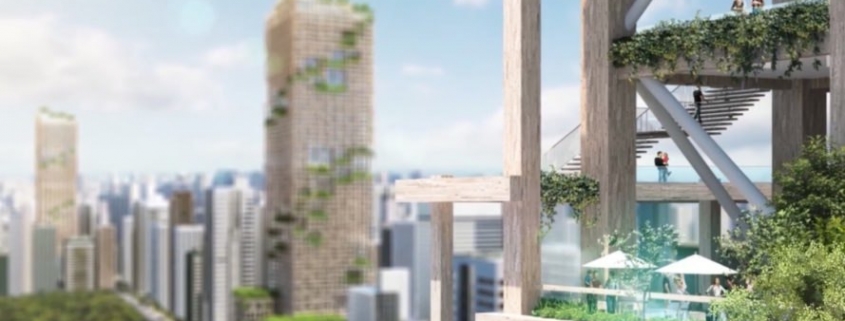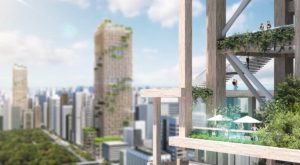Could the “plyscraper” solve the housing crisis?
It’s strong and versatile – not to mention environmentally friendly. Here Shaun Soanes looks at why building with wood could be the answer to our global housing crisis.
Last month it was announced that Japanese architects are planning to build the world’s tallest wooden skyscraper in Tokyo.
Sumitomo Forestry intends to construct a 70-storey, 350 metre-tall building as part of a wider strategy to create more environmentally-friendly cities.
It will be made from 90 per cent wooden materials and approximately 185,000 m³ of indigenous timber will be used – with a steel structure making up the other 10 per cent. The inside design of the building will be “pure wood” which the developers say will produce “a calm space that exudes the warmth and gentleness of wood”.
Bringing wood back
Wood has been used as a building material for thousands of years, being second only to stone in terms of its rich history in the world of construction.
Early examples include the Neolithic long house – a long, narrow timber dwelling popular in 6000 BC which had a capacity of housing around 30 people.
Since then, the discovery of different materials changed the face of our buildings – particularly those of any scale.
Skyscrapers, for example, are usually constructed from steel and concrete.
However, the fact remains that wood is a miracle building material – so environmentally friendly that it extracts carbon from the atmosphere rather than adding to it.
It also can go up at lightning speeds, reduces the noise and disruption of building sites, can be as strong as (yet much lighter than) steel and is very adaptable.
So, it stands to reason that architects want to find ways to use it – and on a much grander scale than ever before.
To do this they have to ensure the wood is as strong as its steel and concrete counterparts.
The Japanese building will use a “braced tube structure” which positions diagonal beams inside a column to protect the building against earthquakes or strong winds.
Engineered timber also provides this option.
It’s created by building up layers of planks, each one at right angles to its neighbours, bonded together with glue.
This makes a sort of ultra-plywood, called cross-laminated timber (CLT). It is strong, rigid and durable, insulates both heat and sound, and can be prefabricated in factories to high levels of quality and precision. You can make floors, walls, stairs and lift shafts out of it.
Sustainable and renewable
It stands to reason that timber construction boasts unrivalled sustainability credentials.
After all, wood is our only renewable construction material, growing using solar energy.
The key benefit of a wooden skyscraper therefore is that its structure comes from a sustainable resource.
The world has come to rely on concrete, steel, aluminum and brick building materials, but a recent study found that 16% of all the fossil fuel consumed every year is used to turn those raw materials into construction products.
Using wood and specially engineered wood products instead would drastically reduce global carbon dioxide emissions and fossil fuel consumption. Managed properly, this could be done without loss of biodiversity or carbon storage capacity.
Put it this way – while 1,000kg of cement emits nearly 1,000kg of carbon in its making, 1,000kg of timber will, through the trees from which it is made, remove up to 2,000kg of carbon from the atmosphere.
Wooden buildings are also proven to reduce stress and lower heart rates.
And to counteract fears about wooden buildings creating a fire hazard, the truth is engineered timber buildings don’t burn easily.
At high temperatures concrete explodes and steel buckles, but wood, if it is thick enough, chars, which forms a self-protective layer. It takes a while for fire to consume it.
Fit for the future
There is one more benefit to building with wood and it has nothing to do with structural strength or carbon footprints.
Wood adds beauty to the interior and exterior of any building.
It is warm to the touch and pleasing to the eye.
So it’s little wonder more and more architects are looking for ways to incorporate it into their building projects for the future.
As for “plyscrapers” – we will be fascinated to see how the Japanese project pans out.



 Bentinck House
Bentinck House


